Hi Guys, Is this the tools you guys are talking about?(picture attached).I might be able to get one or two spare.Please let me know if anyone is interested.
Twang
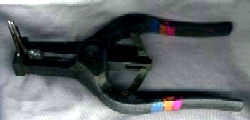
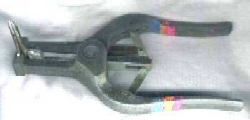
How to install a mike in an MS22001 oxygen mask
Message 3657, Jul 31, 2001
Hi Twang, Yep, that's the tool we were talking about! Is there any possibility of getting
a few of these? I could use one myself and there are apparently several others who
expressed an interest in it, as well. What are the details on this? Thanks. (I took your
image of the tool and changed the light values a bit so as to make it clearer to see).
DocBoink
Message 3643, Jul 31, 2001
Hi Guys, Is this the tools you guys are talking about?(picture attached).I might be able
to get one or two spare.Please let me know if anyone is interested.
Twang


Message 3640, Jul 31, 2001
It is most illuminating to find all the innovative techniques being used to fit com cords
in MS22001 masks, now that Bluelight has introduced this instructive topic. It really
makes me wonder what the military life support folks and personal equipment people who fit
masks for a living would say if they knew that some of us do these things as a hobby,
rather than as an occupational calling! An amusing thought, it seems to me. Thanks
MichaelFox for another approach to the matter.
Cheers, DocBoink
Message 3639, Jul 30, 2001
Hi All, Nice job by Bluelight on installing the mic and comm cord in the O2 mask. I have
found that you can ( and I do ) use a pair of snap ring pliers designed for working on
automatic transmissions. These pliers have two jaws that spread apart when you squeeze the
handles. I had to grind down and smooth the jaws to make them smaller so they would fit
into the hole in the mask. This particular pair are a Craftsman tool and the number is P
4735. I have had them for a long time.
Best regards, MichaelFox
Message 3638, Jul 31, 2001
Hi Maggot, Interesting and creative way of getting around this problem
("Sculpey" moldable clay). I guess I have not been irritated sufficiently to
find myself forced to come up with something equally as clever (and suitable) as this, but
it would certainly seem to do the job (especially used with lots of slippery lubricant).
Thanks for this innovative approach! Anyone else have any pet techniques for inserting
U-173/AIC connectors in MS22001 mask inlet orifices?
Cheers, DocBoink
Message 3637, Jul 30, 2001 10:31pm
I couldn't help but comiserate (did I spell that correctly?) over this latest exchange. I
got tired of wrestling masks, trying to pack nine pounds of s--- in an 8-pound bag (we all
know the routine... I finally made my own tool from a hobby product called Sculpey. It's a
moldable clay-type compound which hardens over time (accelerate the process with specified
oven temps); anyway, I made a long, tapered tool with the large end being the shape and
size of a U-173 connector (complete with holes for the male pins), then baked it and VOILA
- a littel "Soft Soap" for lubricant on the tool (and installing the mic cord
before you put the valves or anything else in) and it's a relative snap! As you can see
from the scan, I've already broken the tip off mine (still has a decent point to get
through the mask body hole), but there's plenty more where that came from... Check your
local hobby & crafts shop, or if I get bored I'll make a bunch of them (a box of the
stuff is enough for at least 50 tools).
Maggot
Message 3635, Jul 30, 2001
Bluelight, This is a great asset for myself and the others, as inserting a mask microphone
cord with the U-173/AIC connector into an old MS22001 mask's mic com-cord orifice is one
of the trickiest parts of mask restoration and/or maintenance. I have split my share of
those tight and narrow little com cord passages on old and brittle MS22001 rubber masks;
this is a minor tragedy, of course, given their great value, scarcity, and irreplaceable
nature. I even disassembled a U-173/AIC connector once, to see how it was put together and
to determine whether or not it was "disassembleable". I found that it was a
complex little connector that could be taken apart, but not without a LOT of work--not
always successful, either, as it was very possible equally to destroy one in the
disassembly process.
Further, the older woven com cords that first had the U-173 connector installed on the mic
end (for the M-32A microphone) had a relatively short cable segment, which did not leave
enough cable length outside the mic pocket of an MS22001 mask, after the U-173/AICX
connector had been passed successfully.
The three-arm insertion tool you mention is the "animal" we all really need if
we are to work with MS22001 rubber masks successfully, although your angled forceps are
certainly the next best thing. Old rubber cable guides seem to predictably break (on the
inside, as you said) when stressed, but so do the com cord passages on the mask that lead
into the internal microphone pocket.
Liberal use of a lubricant is mandatory when working with these things. I have found that
in addition to soapy water, saliva, or other types of lubricant, another good lubricant is
the medical lubricant known as K-Y Jelly. It is available in drug stores and pharmacies.
We used it frequently in hospital operating rooms to pass bronchoscopy scopes and it is
damnably slippery stuff!
One of the basic problems with older rubber MS22001 masks is that the rubber around the
mic pocket and in the area of the cable inlet is frequently so aged and brittle that while
this may have been "doable" when the rubber was new, it may not tolerate that
sort of stretching after years of drying out. I guess the only way we can be sure is to
try it and try to be VERY careful.
I wonder if the RDAF LSE people would be able to provide the name and address of the
company that makes those special insertion forceps for the government? It is possible that
we might be able to track the company down and make a special request for a limited
purchase of a few of them for some of our members. Eventually, just about anything that is
commercially produced (for the government) may be obtained privately, if one perseveres.
I'd love to have one of those three-armed mic connector insertion forceps, myself!
Thanks for the step-by-step procedure and the excellent photographs illustrating your
points.
Cheers, DocBoink
Message 3634, Jul 30, 2001
Hi all, Recently I had the opportunity to look through a Technical Order for an MS22001
mask, and also to discuss oxygen mask maintenance with Royal Danish Air Force ALSE
specialists. Finally I found out how to install a comm cord in an MS22001 mask!
Now, the easy version is if you want to install a simple comm cord with PJ-292 connector.
You just disassemble the PJ-292 connector and push the cord through from the inside. It
may be necessary to wrap a little tape around the end of the cord to keep the cord contact
pins together while you are pushing the cord through. The T.O. describes a special
Microphone Installation Tool which is essentially a long, narrow pair of tongs which will
open instead of close when the handles are pressed together. With those it is easier to
pull the cord through but it is perfectly doable without tools.
The difficult version is when your cord has U-173/U plugs because you cannot disassemble
those little buggers - well, you might, but you will destroy them in the process. The
entire plug has to go through the opening. One of the Danish ALSE guys showed me a special
pair of tongs with three jaws. When pressing the handles together one jaw went up and the
other two to the sides. By using that tool the narrow comm cord opening could be forced
wide enough to make room for the U-173/U plug. Such a special tool is impossible to find
in an ordinary tool or hardware store so an alternative had to be found. I bought a pair
of tongs with long, narrow jaws, the outer third of which were bent 45 degrees.
I have enclosed a series of photos illustrating the insertion of a U-173/U equipped comm
cord in a 1967 vintage rubber MS22001 mask.
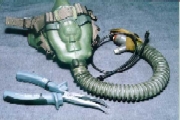
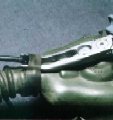
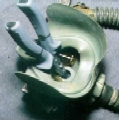

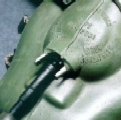
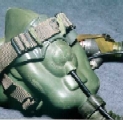
Photo 1 is a "before" shot showing mask, comm cord and tongs.
Photo 2 shows how to pull the cable through the microphone cable guide.
Take care here on an old mask. The guide can be very brittle. If it breaks it will most
likely do that on the inside. It is of course a shame but unless the guide is very loose
it does not show when the mask and helmet are displayed.
Photo 3 shows how the tongs are inserted in the comm cord hole from the
inside of the mask.
Photo 4 shows the jaws of the tongs protruding through the comm cord
opening. I have inserted a small piece of wood between the handles of the tongs in order
to show the jaws partly open in the photograph.
Photo 5 shows the U-173/U plug inside the jaws and halfways inside the
comm cord hole. The tricky part of the operation is to force the handles of the tongs
apart with one hand while you insert the U-173/U. It takes a bit of fiddling before it
enters the hole but it should be fairly easy to do. When the plug is positioned as shown
in this photo, you just pull the tongs and plug out of the hole. It takes a firm pull to
get the tongs out but you can ease the process by lubricating the hole and tongs with
ordinary water. The T.O. suggests using water, liquid soap or saliva (sic!). I prefer
water to avoid any long-term abrasive effects from either soap or saliva.
Photo 6: Voilá!
Yesterday I inserted comm cords in five MS22001 masks and once I got the hang of pulling
the tongs and plug out of the hole, it went like a charm. I deliberately used an old
rubber mask for this photo series to show you that this technique can also be used on
older, more brittle masks. As you can see from some of the photos, one of the rubber
suspension lugs supporting the plastic nose bridge and nose strap is broken and the other
one is severely cracked. I only draw your attention to this in order to demonstrate the
general condition of the mask and to show you that even such a mask will endure this
"maltreatment".
Cheers, Bluelight